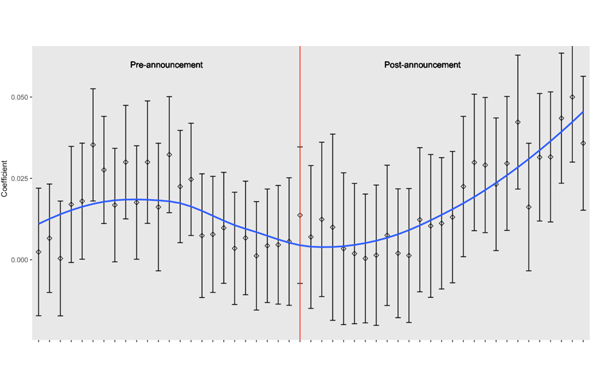New paper on the anticipation (casual) effects of crossrail

How much more are home-buyers willing to pay for a house if they know it is close to a train station that is going to be upgraded? 2.4%, according to a recently published paper in the Journal of Transport Geography co-authored by GDSL’s Sam Comber and Dani Arribas-Bel, which presents a method for quantifying the causal effect that the anticipation of a new commuter railway has on property values.
Anticipated changes to the urban environment should factor into a home-buyer’s decision making when agreeing the purchase of a property. Take, for example, a prospective buyer who walks into an estate agent’s office and is offered a valuation on a property. Typically, this price estimation will be conditioned on the number of rooms, the proximity to local amenities and perhaps even the anticipation of a new major public investment – a shopping mall, leisure park or even a railway line. The announcement of such external interventions are factors that should influence the buyer’s willingness to pay for the property.
But, how does one measure and quantify this? We use data on property transactions for the London Borough of Ealing, and we study the effect, if any, of the 2008 announcement of Crossrail, a 118 kilometre commuter railway stretching across and beyond East and West London. We assume that, if there is any effect, it will be felt more intensely the closer a house is located to one of its stations.
Our approach is one of the first to combine differences-in-differences, a widely used technique for the estimation of treatment effects, with spatial econometrics, a set of methods that explicitly include the effect of space in the estimation of regression coefficients, to recover the causal effect of the 2008 announcement of Crossrail on house prices in Ealing.
Our best estimate finds home-buyers were on average willing to pay 2.4% extra for a property close to Crossrail stations after the announcement. That is, every Km. that a house is away from one of these stations, we find house prices penalized on average 2.4%, but only once the project was announced. Because our method compares the differences between house prices that are close and far from the station (difference 1), before and after the announcement (difference 2), this estimate is “clean” from additional factors that affect the price of houses sold in that period.
A final remark worth noting here is that this project started as Sam’s undergraduate dissertation while in Birmingham, was awarded a dissertation prize and, with Dani’s mentoring, was pushed into the published paper. This story shows you should never underestimate the power of smart undergraduate students with open data and open-source code at their reach!
The paper is open access and code and data used for the study are released as open source and available in an online repository.